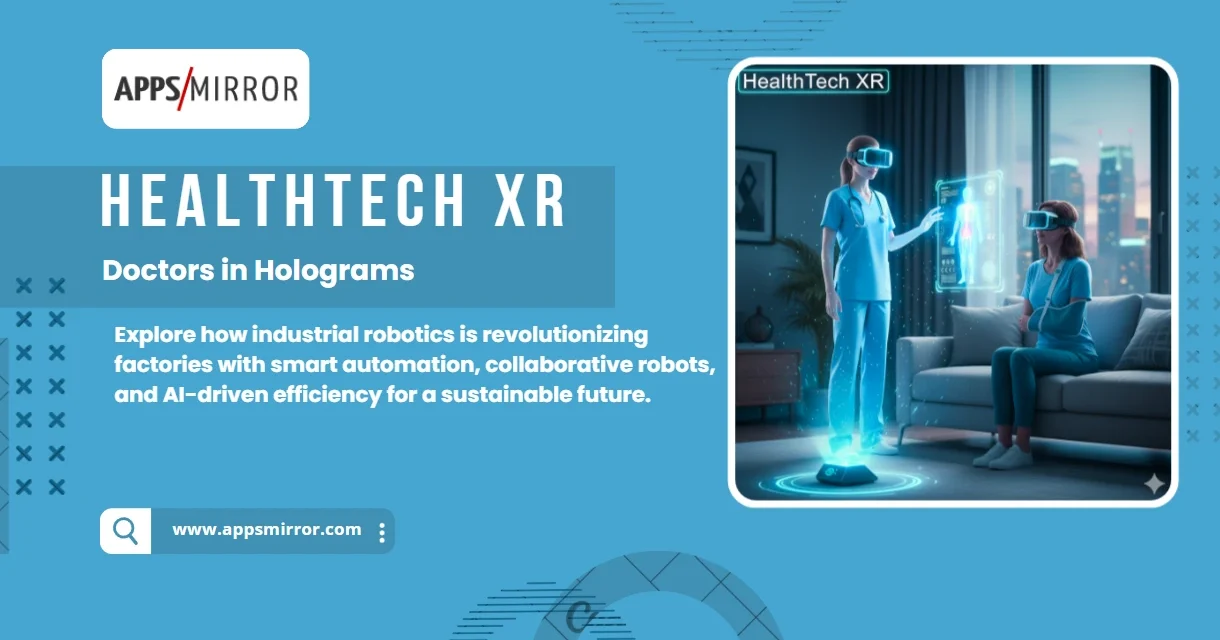A New Dimension in Healthcare
Picture this: instead of sitting in a waiting room, you put on a headset at home and suddenly, your doctor appears in your living room as a life-sized hologram. This isn’t a science fiction movie—it’s the direction healthcare is heading, thanks to Extended Reality (XR), a term that covers both Augmented Reality (AR) and Virtual Reality (VR).
HealthTech is one of the industries where XR has the potential to make the biggest impact. From virtual consultations to immersive surgical training, XR is opening doors to healthcare that is more accessible, more accurate, and more human-centered.
For deeper insights on how XR is reshaping modern healthcare, visit Forbes – How Extended Reality Is Transforming Healthcare.
Holographic Consultations Become Real
Telemedicine became mainstream during the pandemic, but video calls have limitations. Doctors can’t always observe body language, and patients often feel the lack of “human presence.” XR changes this dynamic by bringing doctors into patients’ homes as holograms. Patients could rotate digital scans, show physical symptoms in 3D, or even walk a doctor through their environment.
This level of immersion makes remote consultations more personal and allows for better diagnosis. For patients in rural or underserved areas, XR eliminates the barrier of distance, giving them access to quality care without long travel times.
Training the Next Generation of Doctors
Medical training has always relied on textbooks, cadavers, and simulations. XR offers a new dimension: immersive, interactive practice without risk to patients. Aspiring surgeons can step into VR operating theaters, rehearse complex procedures, and even experience mistakes in a safe environment.
AR overlays are also being used in live surgeries, guiding doctors with real-time information—highlighting arteries, showing patient vitals, or projecting 3D models of internal organs. These tools enhance precision, reduce risks, and create opportunities for global collaboration in medical training.
Beyond Hospitals: Mental Health and Rehabilitation
The applications of XR extend beyond surgeries and consultations. Therapists are using VR to help patients overcome phobias by exposing them to controlled virtual environments. For example, someone with a fear of flying can “practice” boarding a plane in VR before facing the real thing.
In rehabilitation, VR programs help stroke patients practice motor skills in gamified environments, making recovery less monotonous and more motivating. XR is also being tested in pain management, where immersive environments reduce patients’ perception of pain during treatments.
The Challenges to Overcome
While XR in healthcare is exciting, several challenges must be addressed.
- Cost: XR hardware and software remain expensive, making adoption difficult for smaller clinics.
- Accessibility: Patients in low-income regions may not have the devices or connectivity required.
- Data Security: Handling sensitive medical information in virtual environments raises privacy concerns.
- Learning Curve: Both doctors and patients need training to effectively use XR tools.
Without addressing these barriers, XR risks becoming a tool for the privileged rather than a global healthcare solution.
Key Players and Innovators
Tech companies and startups are driving XR adoption in healthcare. Microsoft’s HoloLens is being used for surgical overlays and medical training. Osso VR specializes in immersive surgical education. XRHealth offers virtual therapy clinics for patients at home. Even giants like Meta and Apple are exploring XR hardware that could eventually integrate with health applications.
Hospitals and universities are also investing heavily in XR labs, ensuring that the next wave of doctors grows up fluent in immersive technologies.
What the Future Looks Like
Looking forward, XR will likely merge with AI and IoT to create fully integrated healthcare ecosystems. Imagine a holographic doctor reviewing your wearable health data in real time, projecting your digital twin, and suggesting personalized treatments. Global collaboration could also expand, with experts across continents “joining” surgeries through XR to offer guidance.
In the long run, XR might even reduce healthcare inequality. If hardware becomes cheaper and more accessible, people in remote regions could receive the same level of expertise as patients in major cities.
Technology for Good
The vision of holographic doctors may sound futuristic, but it embodies the best of what technology can offer: accessibility, empathy, and empowerment. XR in healthcare doesn’t aim to replace human doctors—it enhances their ability to reach, teach, and heal. By breaking down barriers of geography and cost, XR can help build a world where quality healthcare is not a privilege but a universal right.
To explore how immersive technology is shaping compassionate and inclusive healthcare, read more at World Health Organization – Digital Health and Innovation.





